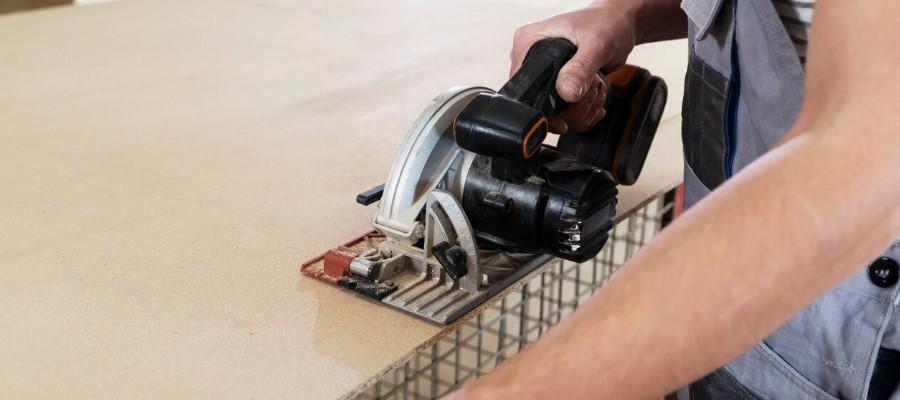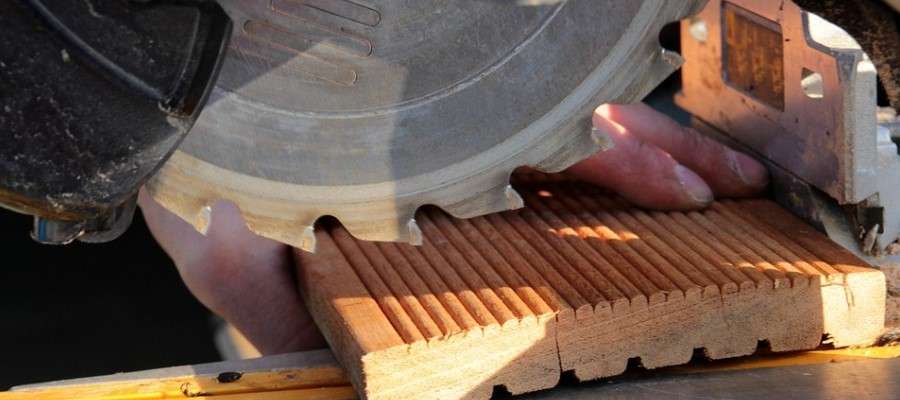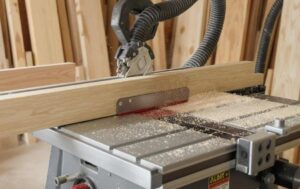If you want to know how to use a circular saw without a table, you’re in the right place. Even without a big workbench or table saw, you can make clean, precise cuts with a handheld circular saw. By using simple tools like sawhorses, foam boards, and straight-edge guides, you’ll learn how to set up a safe and stable workspace. This step-by-step guide is perfect for beginners and DIY enthusiasts who want to cut wood accurately without needing a table saw.
You don’t need expensive tools to get advanced-level results, just the right techniques, patience, and a clear plan. Safety tips and real-world-tested advice throughout this guide will help you build confidence with every cut.
Table of Contents
Why choose a Circular Saw Without a Table?
Not everyone has space for a big table saw. Circular saws are lighter and cost less. You can move them to your work area. They work great for home projects and repairs.
Many pros use handheld circular saws on job sites. They’re fast and give good results. You just need to know how to set them up right.
Circular Saw Safety Tips
Before using a circular saw, stop and think about safety first. This powerful tool can cut wood cleanly, but it can also cause injury if used carelessly. Be sure to wear safety glasses to protect your eyes from flying dust and debris. Use hearing protection too, as saws are loud. Keep your hands away from the spinning blade and never remove the safety guard.
A sharp blade makes cleaner cuts and lowers the risk of accidents. Check it before each use to make sure it’s not damaged or loose. Also, be sure the power cord is out of your cutting path to prevent kickback. Work in a bright, clean space so you can see clearly and move safely. Hold the saw with both hands and keep a firm grip. Power tool safety is not about fear; it’s about control. A few smart habits can protect your hands, your project, and your confidence. Whether you’re making rough cuts or fine ones, following these circular saw safety tips will help you cut with care every time.
What You Need for Handheld Cutting
Basic Equipment:
- Circular saw with a sharp blade
- Straight edge or cutting guide
- Clamps or weights
- Measuring tape
- Pencil for marking
- Safety gear
Choosing the Right Blade for the Job
Choosing the right circular saw blade is key to getting clean, safe cuts. For rough cuts in thick lumber, a 24-tooth blade works fast but leaves a coarse edge. If you need smoother cuts, try a 40-tooth or 60-tooth blade. These blades give you finer results and less sanding later. When cutting plywood or laminate, a fine-tooth carbide blade helps prevent tear-out. It also gives a crisp, clean edge. Always check if your blade matches the material. The wrong blade can burn the wood or cause splinters. Keep your blades sharp and clean to avoid rough edges or binding. A quality blade also lowers the chance of kickback.
If you’re cutting hardwood, choose a blade made for tough jobs. For softwood or framing work, general-purpose blades will do fine. With the right blade, your circular saw will cut faster, straighter, and safer every time.
Support Options:
- Two sawhorses
- Scrap wood pieces
- Foam boards
- Workbench edge
The right blade makes a big difference. Use fine-tooth blades for smooth cuts. Coarse blades work better for rough cuts and thick wood.
How to Set Up a Circular Saw Cutting Station
A solid setup can mean the difference between a clean cut and a crooked mess or worse, an injury. Let’s set things up right. Start by finding a stable work surface. Sawhorses work great for long boards. You can also use a workbench or table edge.
Place your wood so both sides of the cut line have support. This stops the wood from falling and binding the blade. The piece you’re cutting off should hang over the edge.
Make sure nothing is under your cut line. You don’t want to cut into your table or floor by mistake. If you are working indoors or on delicate surfaces, place a rigid foam board or scrap plywood underneath. This protects your floor or table from damage.
How to Cut Straight Without a Saw Fence

A straight edge is your best friend for precise cuts. You can use:
- A-level or straight board
- The factory edge of plywood
- Metal ruler for small cuts
- Purpose-made cutting guides
Clamp your straight edge to the wood. Measure from your cut line to where the saw base will ride. This distance varies by saw model. Test with scrap wood first. After cutting, it’s important to keep your workspace clean.
Step-by-Step Cutting Process
- Mark Your Cut Line: Use a pencil and square to mark a clear, straight line.
- Set Blade Depth: Adjust the blade so it’s about 1/4 inch deeper than your wood thickness; deeper isn’t safer. Before you start, make sure the blade is installed correctly. The teeth should point forward, matching the arrow on the saw’s guard.
- Position Your Guide: Measure and clamp your straight edge in the right spot. Double-check your measurements.
- Start the Cut: Turn on the saw before touching the wood. Line up the blade with your mark and begin cutting slowly.
- Keep Moving: Don’t stop mid-cut. Maintain a steady speed and follow your guide closely.
- Finish Clean: Cut through completely. Turn off the saw only after the blade stops moving.
Supporting Long Boards and Sheets
Cutting long boards or plywood sheets requires good support to stay safe and get clean, straight cuts. Use at least two sawhorses, spaced evenly under the wood. This helps prevent sagging or blade binding during the cut. For full-sheet plywood, foam insulation boards work great. Lay the sheet on top of the foam, the circular saw blade can pass through the wood and into the foam without damage. It gives solid support across the whole surface.
For thick wood, try the kiss cut method. Make a shallow cut first, then flip the board and finish from the other side. This reduces splintering and helps avoid saw kickback. A well-supported board makes it easier to control the saw and get accurate results. Whether you’re using a cordless circular saw or a corded one, stable support is key to both safety and precision.
Common Cutting Techniques
Rip Cuts (With the Grain): These are long cuts that follow the wood grain. Use a rip guide if your saw has one. Or clamp a straight board as your fence.
Cross Cuts (Against the Grain): These cuts go across the wood grain. They’re usually shorter. A speed square works great as a guide for cross-cuts.
Angle Cuts: Set your saw base to the angle you want. Most saws tilt from 0 to 45 degrees. Use an angle guide for best results.
Plunge Cuts: Sometimes you need to start a cut in the middle of a board. Tip the saw forward on its front edge. Lower the blade slowly into the wood.
Common Problems
Blade Binding: Happens when the cut closes and pinches the blade. Keep both sides supported and avoid twisting the saw.
Rough Cut Edges: Caused by dull bladesreplace or sharpen blades regularly and cut slower if needed.
Saw Wandering Off Line: Usually due to not following the guide closely. Keep steady pressure and take your time.
Kickback: The saw jumps back when the blade binds. Maintain a firm grip and don’t force the cut.
Measuring and Marking Tips
Accurate measuring saves time and materials. Always measure twice before cutting. Use a good tape measure and a sharp pencil. For repeat cuts, make a story stick. This is a board marked with your common lengths. Just hold it against your work piece and mark. A speed square isn’t just for marking, it’s also one of the easiest ways to guide your circular saw for perfect shortcuts. It works as a ruler and a saw guide for shortcuts.
Advanced Cutting Methods
1. Circular Saw Guide Rails
Use long aluminum guide rails that clamp to your workpiece. They help ensure every cut is perfectly straight, great for large or multiple cuts.
2. DIY Cutting Jigs
Create custom jigs using scrap wood and clamps. A stop block can help make consistent, repeat cuts at the same length.
3. Cutting Extra-Thick Materials
When the wood is thicker than the blade depth, make a cut halfway through, flip the board, and finish from the other side. This method reduces splintering.
Maintaining Your Circular Saw
A well-maintained saw cuts better and lasts longer. Keep the blade sharp and clean. Replace dull blades right away. Clean sawdust from the motor vents after each use. Check the cord for damage. Oil the base if your manual says to. Store your saw in a dry place. Keep extra blades sharp and rust-free.
When to Choose This Method Over Table Saws
Handheld circular saws are best when you need flexibility and portability. They work well on large sheets of wood that cannot fit on a table saw.
If you are working outdoors or at a job site without a dedicated workspace, a cordless circular saw is a great choice. These saws allow you to cut wood, plywood, or laminate with ease.
For small workshops or hobbyists on a budget, circular saws offer an affordable way to make quick, rough cuts. On the other hand, table saws are designed for precision and repeated cuts, making them ideal for production work or fine woodworking. If you often cut small pieces or need very accurate, straight cuts, a table saw might serve you better. Both tools have their strengths. Knowing when to use a circular saw instead of a table saw can save time and improve your project’s quality.
FAQ
Can you use a circular saw without a table?
Yes, you can. With proper support like sawhorses or foam boards and a straight edge guide, you can make clean and accurate cuts using a circular saw without a table.
What can I use to support wood when cutting without a table?
You can use two sawhorses, scrap wood pieces, foam insulation boards, or the edge of a sturdy workbench to support the material while cutting.
How do you make straight cuts without a fence?
Use a straight edge like a level, a factory edge of plywood, or a guide rail. Clamp it securely and run the saw base along it with steady pressure.
What’s the safest way to cut long boards?
Use multiple sawhorses to support both sides of the cut. Always ensure the board is stable.
Final Thoughts
When learning how to use a circular saw without a table can feel challenging at first. But with practice, it becomes easier and opens up many DIY opportunities. Always take your time and check your setup carefully before starting. Try cutting on scrap wood first to build confidence. Remember to wear safety gear and work in a clean, well-lit area.
If you want to improve your skills, keep learning and practicing regularly. Bookmark this guide or share it with friends who enjoy woodworking. Taking breaks when you feel tired helps avoid mistakes and accidents. Mastering the basics of circular saw use will make your projects safer and more precise. Over time, your circular saw will become one of your most valuable tools in the workshop.

Welcome to Homenias, I’m Jaman M, and I’m here to help you discover the best home products. With years of experience, they offer genuine reviews and helpful guides. Their mission is to make your choices easier. It’s organizing your space or finding creative solutions. Explore how the right products can enhance your everyday life. Don’t miss out on finding the best home products to raise your living experience.





